FishbonesAir
Active member
So, I got curious about some things with Dollar Tree (Adam's brand) foam board.
What's the stuff actually weigh? How much of that is paper, and how much is foam? So here's what I came up with.
Sample size: 10 cm x 10 cm
Weight: 2.909 g
Weight of paper: .777 g & .768 g = 1.545 g
Foam weight: 1.364* g
* actually putting the foam on the scale is an exercise in static electricity & scales... after discharge, it settled close to that calculated number, 4 out of 5 times. As the static charge builds, the foam weight increases.
Conclusion: the paper on the foamboard does weight more than the foam core. Something I found out, that I didn't expect, was that the foam has a definite grain of sorts to it. That is, it bends easily one way, but is very stiff turned 90 degrees. This grain runs the length of the board; excellent for our purposes when building wings, but also worth noting on wide stabilizers.
Disclaimer: I only sampled one piece from 1 board from 1 store. I can tell you, the boards I bought were not that consistent in thickness and quality. I noticed this after getting them home from the store. The sample was taken from one of the best sheets.
What's the stuff actually weigh? How much of that is paper, and how much is foam? So here's what I came up with.
Sample size: 10 cm x 10 cm
Weight: 2.909 g
Weight of paper: .777 g & .768 g = 1.545 g
Foam weight: 1.364* g
* actually putting the foam on the scale is an exercise in static electricity & scales... after discharge, it settled close to that calculated number, 4 out of 5 times. As the static charge builds, the foam weight increases.
Conclusion: the paper on the foamboard does weight more than the foam core. Something I found out, that I didn't expect, was that the foam has a definite grain of sorts to it. That is, it bends easily one way, but is very stiff turned 90 degrees. This grain runs the length of the board; excellent for our purposes when building wings, but also worth noting on wide stabilizers.
Disclaimer: I only sampled one piece from 1 board from 1 store. I can tell you, the boards I bought were not that consistent in thickness and quality. I noticed this after getting them home from the store. The sample was taken from one of the best sheets.




